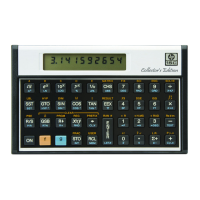110 Section 10: The Index Register and Loop Control
For example, the number 0.05002 in a storage register represents:
nnnnn x x x y y
0.0 5 0 0 2
Start count at zero. Count by twos.
Count up to 50.
I and e Operation. Each time a program encounters I or e
it increments or decrements nnnnn (the integer portion of the loop
control number), thereby keeping count of the loop iterations. It
compares nnnnn to xxx, the prescribed test value, and exits the loop by
skipping the next line if the loop counter (nnnnn) is either greater than
(I) or less than or equal to (e) the test value (xxx). The amount
that nnnnn is incremented or decremented is specified by yy.
With these functions (as opposed to the other conditional tests), the rule
is “Skip if True”.
False (nnnnn
≤
xxx)
True (nnnnn
>
xxx)
instruction
´ I V
loop
t .
1
instruction
exit loop
For I: given nnnnn.xxxyy, increment nnnnn to nnnnn + yy,
compare it to xxx, and skip the next program line if the new value
satisfies nnnnn > xxx. This allows you to exit a loop at this point when
nnnnn becomes greater than xxx.

